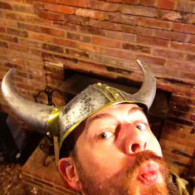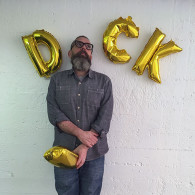Transcription
[Digital music]
Wesley Grubbs: So, I run a data visualization studio, as Marc said, in Oakland, California. We’re called Pitch Interactive, and we’ve been doing data visualizations for about 12 years. But, I’ve been in the interactive industry for a good 23 years. Full disclosure here: 20 years ago, I lived in Dusseldorf where I had the job title of Web Master.
Audience: [Laughter]
Westley: FrontPage 98 was the tool of the day, and I learned a lot at that time.
When Marc invited me to speak here at Beyond Tellerrand this year, I was going through a breakup with a client, and it was a very uncomfortable situation. That breakup inspired this talk today because very often we like to get up here and talk about our successes to inspire, and I think inspiration is a really important aspect but, sometimes, behind those curtains of success, we have to deal with failure on a continued basis.
What I wanted to do was, to the best of my ability--we’re in Germany. I can get a little philosophical, maybe--is to kind of break failure apart. What is failure, and how do we deal with it?
Let’s just look at the definition. Failure: The lack of success.
What is success? Success is when you have an aim of something and you achieve that aim. Knowing, though, that during projects our aims chain.
Subnormal quality: This is a big part of the failure component that I’ll try to talk about today when something kind of sucks to you. It’s totally subjective idea thinking.
The other one is nonperformance of something expected, so something doesn’t work out the way that you expect it to.
We’re in Germany. I know that not everyone here speaks German but, just for linguistic comparison, I thought we’d use the German definition of this as well: fehler. Germans have a little, slightly different twist on this as well.
By the way, I found these definitions on the Internet, so it’s totally not fake news. It’s very true.
Audience: [Laughter]
Westley: One is “ein falsches Verhalten,” which is a wrong behavior. The second one is kind of my favorite because it’s a very German way of explaining things like, something that is wrong.
Audience: [Laughter]
Westley: Something that’s wrong. And then, the bottom one is very similar to the English where there are pieces or components that aren’t quite as perfect as you expect them to be.
But, here’s the point is, when we use the word “failure,” when we’re like, “Ah, this was a failure,” very typically as a society, we’re thinking of a full system explosion or something. Also, then, especially in the States, I work a lot with Facebook and Google. You go there on their campus, and they have big quotes like “Fail Hard” and “Fail Fast” and “Embrace Failure,” and that’s not really what I’m talking about today. I’m actually wanting to use real examples of projects that have failed.
Here’s my point. Failure can happen with the process of a project as you’re going along. The relationship, so the relationship with the client, the relationship with your coworkers. I’ll even extend this further as to the relationship with your private friends and your partner at home if you’re working your ass off to try to get a project done.
Failure can happen with the outcome. You’re just not satisfied with it. The client is not happy. There’s a budget failure. You’re over budget. Under budget, I think, is a success.
A really important component for me is having fun. I think it’s important to note that we wake up every day with a choice. We choose where we go to work. We choose who we are with. Sometimes we forget that. We don’t think that’s a choice anymore. It took me a long time in life to realize everything I do is a choice.
In knowing that, keeping that in mind, the work that we’re doing, we should be having fun doing that too. It’s not always fun, but it should be as much fun as possible. We should have that in mind. If we’re working on a project that’s just not fun, it’s not fulfilling, it’s not satisfying, it has a component of failure with it.
Now, let’s understand failure from a measurement term. If we were to have two variables to measure failure, one is your knowledge gained and the other one is consequences. So, how much have you learned from this mistake, and what are those consequences of that?
If we were to put that on a quadrant, we have four key quadrants that we can do with: your high consequence, low learning; low consequence, low learning -- you Germans love this, don’t you?
Audience: [Laughter]
Westley: High consequence, high learning; low consequence, high learning. [Laughter]
Why would I even do this talk? I think that this is a really important component. It’s how we handle difficult times and situations that really make us stronger. Success is great. It feels good. It builds confidence.
Success doesn’t necessarily make us stronger. It’s how we’re dealing with those hard moments and when there are glitches, and they don’t work the way we expect them to. That’s when things become really difficult.
Let’s go into some work; a project where we had low consequences, high learning. This is at the Facebook headquarters in Menlo Park in their partner center. What you see on this wall is a 4x5. These are 55-inch HDTVs. It’s a multitouch wall, 36 touchpoints. This has been up there for almost five years. For all measurements, at the very end, generally speaking, it was a success. When we see this project, it’s at their partner center, so any guests of Facebook, when they come into the building, they typically will see this first. They go up, and they interact with it. It’s really fun watching people do it.
The test day for any hardware is Halloween when all the parents bring their kids because they totally break this shit. It’s funny. They kick it and do all kinds of things.
But, getting to this end result, like, we get up here and we talk. If I were to use a sports analogy, let’s say baseball; this is not the best place to bring up baseball. Baseball has a really good comparison here where, when you’re watching baseball, people like to watch the home runs and hitting the ball out of the field. You run around all the bases. All those points are scored. But, getting to those home runs, you’ve got to make a ton, thousands of foul balls, strikeouts. You’ve got to hit all of these things through.
While we’re working on these projects, we’re in this sort of explorative process. In this creative, explorative process, we’re playing with different ideas.
This is a component. We had the globe. We had different nodes going around the globe. It’s supposed to be up on the side like this too. Trust me; you don’t want to see the whole thing. It’s kind of ugly.
Audience: [Laughter]
Westley: But, it was this idea of exploring something in an iterative way, and I dare say that this is a failure. The creative process, by design, is inefficient, and we have to work with that inefficiency. It’s always these sorts of dead ends. But, it’s those dead ends; that’s how we learn.
We’re refining. Oh, I learned something from this. Delete all of this. Move on. Do something else.
I think that’s an interesting thing to know. It’s sort of like experiments with disappointing results. We might have liked the result, like, “Oh, this was cool,” but we know this is not going to be the end result of the product. We know the client is not going to like this, and it’s not even very legible, useful, or anything like that.
This was another visual of just playing with this. I’m not sure what we were trying.
This was another one, too, where you’re just putting Perlin noise or some sort of noise algorithm on this to kind of play with it, knowing that you’re not trying to make any final result here that’s exactly what you want to do, but you have to start exploring. Each one of these, this is hours of work, sometimes days, and it’s work that gets discarded.
That’s the part where you’re learning a lot, but your consequences are very low. You almost build an environment. That’s sort of the ideal place to have that failure. This is a lot of times where the Facebook and the Google are like, “Yeah, fail hard,” which means, keep doing shit like this.
I had to plug this in. It’s sort of like making these falsch visuals to get the right one. We need the falsch to get the Richtig.
Walking around here yesterday, I saw English brutalized so many times.
Audience: [Laughter]
Westley: Now it’s my turn to brutalized the German.
[Applause]
Westley: This is another project. What you see here is several years’ worth of reservoir data from California reservoirs. Up to a few years ago, we were in a very excessive drought in the state, and that drought lasted for about five years.
What’s really cool is that all the reservoirs in California have sensors on them, and that sensor, because it’s federally funded, is open source data if you know how to get there. Sometimes government data is the hardest to get. Maybe this is changing today with Trump. I’m not going to go there, though. Trust me, you don’t want me to.
This is several years’ worth of data, and we’re just kind of mapping out this data to see what we can find with it. Where we got to, in the end, was something like this. The width of these bars, this is representative of every reservoir in California. The thickness is the size of that reservoir. The height of the blue bar is the percentage of fill of the reservoir at that time. Once it reaches the top and it goes over 100%, they have to spill out.
You can sort of see a timeline. There’s a little bit of a story here. But, what we did with this project is we had two weeks’ of our own time.
We do this regularly at the studio where we’ll do passion projects. We say, in two weeks, let’s see what we do. It’s a different idea than saying, “In two weeks, let’s do something that we can publish.”
For us, it’s more about, let’s be mindful about this. Let’s get the data, and let’s see what’s reasonable. Let’s understand this in two weeks, and maybe we’ll pick it up later.
That’s where we got. This was as far as we got. We didn’t do anymore. It never saw the public eye. This is actually the first time I’m showing it. This was done a couple of years ago, so it kind of got shelved. But, we learned from something from that in that process.
In a way, this is a failed project. It never got out there. But, for us, we were still learning with that.
Here’s a fun project: high consequence, high learning. We were contacted about three years ago by Mozilla. I notice Mozilla is a sponsor of Beyond Tellerrand, so that’s going to make this story a little bit more interesting.
They approached us to redesign their logo. We’re a data vis studio. We’re not an ad agency. We don’t do logos. We’re terrible at improvising. We are technologists first, and we plug in data, we write a bunch of code, and then we play with these visual outputs of it.
They wanted a data-driven logo, a logo that was live, that was breathing, that was using real-time data. That got us really excited, and we were like, “Yeah, let’s do this.” Never did a logo before, but okay.
We started playing with a couple of different ideas, different sections, different concepts, maybe this. They looked at it. They were like, “Nah, I’m not liking it.” Okay, “How about some of this?”
“Yeah, there’s not really anything here I like.” This was presentation after presentation.
“Maybe some of this?” I don’t know. Self-doubt is starting to pick up, a lot of uncertainty.
This is the thing about failure that we get uncomfortable with is it creates uncertainty, self-doubt, disappointment. It’s a natural human experience to want to deflect those emotions. My argument is that, actually, we need to not really accept them, but be aware of them, to be able to sort of analyze them.
What about this? Some of these, I really liked. I was like, man, damn, they are hard.
This is funny. This is when channeling Jared Tarbell. The Space Invaders. We got desperate. We were like, let’s just steal. Who else has done some cool stuff?
But, it’s kind of a cool idea. There’s a grid, and if you imagine different components of the grid playing out like a heat map, and there’s a symmetry of that grid, so each one of these squares would be a heat map of a value from Mozilla data, like Firefox usage or something like that. Then it would make some sort of live Space Invader based on that. They hated that idea.
Audience: [Laughter]
Westley: Let’s do some more. Look, more Space Invaders. These are all concepts that we were doing where there’s some data component, there’s some numeric value. Pretty exhaustive, huh? Lot’s of failures here. Oh, my God!
We started narrowing them. After months of months of headaches and deliberations and the moment where I almost walked out of a meeting with my middle fingers--
Audience: [Laughter]
Westley: --we finally landed on something. They really pushed us hard, and we learned a lot from this process. And so, what we did was -- it’s so funny. Sometimes that final result is so simple, and it’s like, oh, that’s so easy to get to. But, the work, the path to get there is such a hard one.
We were taking usage stats from Sumo, Bugzilla, Firefox. Bugzilla is where bug reports are noted and things like that. Every day, there are dozens of different bugs that are reported. We can map that out on a histogram.
This typeface, it was made by Erik Spiekermann, Fira Sans. It was great working with him, too.
You take these graphs. You tilt them on their side. Then you have this logo, in the end. We even built a working construct of this, how to customize your own logo.
The whole idea, because this was Mozilla’s thing, is open source, community. Let people go in and make their own logo. They can select their data set. They can select from a set of colors, and then they can output it and incorporate it into whatever feed or wherever they want to use it.
We were really excited, and this was kind of towards the end of the project. We were really excited. They were really excited. Their creative director even started making brand kits for this. This was what the logo mark might look like, and this is how it is.
Then the project lead that we were working with left Mozilla to go work at Twitter. Shortly after that, there was a leadership reshuffle in Mozilla.
If you look at the logo today, this is what it is. We had nothing to do with this. It’s not Fira Sans. This came out, I think, six or eight months ago.
It was literally a project that we worked so hard with, so many months on, that just died, and for reasons that were outside of our control. But, it’s just one of those things that happen.
It’s like, okay, well, we learned a lot. I think the big consequence of that was that we’d spent six months doing something that we didn’t really have much to show for, from a portfolio or going out and speaking about it at conferences. This is my first time talking about this. It was just a lot of effort that did not meet its goal. It didn’t meet what we aimed for it to go for.
But, this is not a bad logo. I’m not going to talk shit about it. I think it’s fine, but it’s also understandable. If you’re a leadership and you come on, and especially if you’re leadership in a creative director role and a whole different team has been working with something creative like a logo, before you, I think ego comes into play there, and human nature comes into play, and you want to make sure that logo has got your influence on it. I am just assuming that that leadership was interested in having their own thing.
They even sent videographers to our studio. There is a YouTube video interviewing me, and it’s this deep analysis of the logo process and how successful it was going to be.
Low consequence, low learning: This one is a fairly quick one to talk about. But, before I show the visual for this, it’s really important to know this. You have to know when to walk away from a project; when to say no.
This was a project for a big, multinational corporation. I’m not going to say their name. We’ve worked with them in the past; had great relationships with them. This was a different division. They wanted us to do a visualization on additive manufacturing, which is like 3D printing, but on a manufacturing level, like engine parts and things like that, which sounds really exciting and interesting.
Three calls in, we just realize we have no idea what we’re doing on this project. Usually, when we start projects, we just have a couple of basic questions. We’re a data vis studio, so we need data.
Where’s your data? What is this for? Who is this for? What do you want them to get out of this? Answer those questions, and we’d love to work with you. But, when those questions aren’t answered, it’s really hard to think positively that a project is going to work out great.
This was one where we were really, like, help us understand this more. Three calls in, we don’t understand. Can you do something? He was like, “Yeah, I’m going to sketch this. I’ve got an idea. I’m going to sketch it out. I’ll give it to you.”
I’m not even going to try to read this because I can’t read this. Once we saw this, I was like, nothing is clearer. We only have more questions. It’s just that point, like early on in the project. I think it was like Vic was saying yesterday is, “Don’t be an asshole.”
But, it’s like, hey, just be honest about it, like, “We’re having a hard time understanding this. I think that you should be working with somebody else.”
He’s like, “Okay. I respect that. That’s fine,” and we parted ways early on, so there was not a big consequence. We’re not enemies. We’re totally friends - frenemies.
Audience: [Laughter]
Westley: High consequence, low learning: These are the hard projects, and I have no visuals, and I will give no names. This is the one where, when Marc contacted me, this was an NGO. It’s a nonprofit, which nonprofits aren’t always the easiest companies to work with. But, they had hundreds and thousands of rows on women all around the world throughout their lives on fertility, on education, on income levels, on domestic violence, on a number of really fascinating, meaningful issues to try to really understand how have women’s rights changed around the world over time.
When they first approached us, we were excited. We were fuzzy tailed, is a word that we use in English. I’m sure the German word is some long--
Audience: [Laughter]
Westley: Can anyone think of a translation for fuzzy tailed? I’ve got to say it here. Do you know what fuzzy tailed means? You’re so excited, your tail, like poof. [Laughter]
Like a foxtail, not -- oh, shit. My German.
Audience: [Laughter]
Westley: [Laughter] That’s just so bad.
Audience: [Laughter]
Westley: We were talking with them. We’re really excited. We did all the requirements. We build up a contract. Our contracts could not be more defined, and we sort of explain our contracts that these, our statement of works, they’re sort of like instructions for a game, when you go buy a game at a store. It’s how to play the game. This is how we work.
This is our timetable. In two weeks, we’re going to show this. This is the feedback. We need it by this time. This is what to expect. These are the parameters. Here’s a Gantt chart showing the entire schedule, a visual. We’re a data vis studio, so we have visual schedules. It couldn’t be more clear - unless you don’t read it.
One of the things in there is, we need a single point of contact with our clients. The CEO of this company was so excited about working with us, they were fuzzy tailed too, the foxtail. He was like, “I’m going to come out there and personally see these visuals. I’m so excited.”
He flew out to see it; gave his thumbs up. He was like, “This is great. I totally approve. I just have to run this by my team, but I approve.”
And so, what happened was, he went back, and they had this internal meeting with about 20 people, and we weren’t a part of that meeting. All these other people had seen our work that we’d been doing for two weeks and had questions, and we weren’t there to answer anything.
They came back with an entirely new set of requirements for the project, an entirely new design, and all the work that we had to do. We had three weeks left on this project. There was a timeline, which was like a conference or an international seminar.
My first reaction was fury. I was just angry because of that disappointment. I was like, “Damn it! This did not work out. We cannot do this by that time. Not only that, we need to double the budget,” and the budget was already fairly low.
Everyone got upset. When we realized that, we had to sit down and talk and say, “We can’t do this.” It wasn’t pretty on any side, so that happens. I think it’s important just to realize that those situations happen.
This is another one, another client I can’t talk about. It’s a recent one. I really loved the output of this. It was just kind of one of these home runs for us, that we thought.
We have five columns. Let’s just say above those columns are things. I can’t say anything more than that. Those things were ranked across the world in a value of zero to 100.
The methodology of representing this is called a parallel coordinate diagram. It’s not new. It’s interesting when you put some styles and you play with the color and shapes and forms and all that. But, for me, this was exciting. There are all these patterns here.
The thing about data visualization, it’s specifically different than infographics. Those are very different things. A data vis is something you look at, and you can look at different patterns as you’re looking through it. Like, oh, I see this. Oh, look at this country. Oh, look at what countries are clustered around this particular thing.
I almost just said what that was.
When we showed it to them, they were like, “Uh, I don’t know what I’m looking at. This is really complicated. This is confusing.” We were upset. What it turned out they really wanted was an infographic. An infographic is like if I were to have a big percentage that said 14%, and I said, “14% of everyone in this room is left-handed.” That’s an infographic. It’s not really an explorative thing. It’s a piece of information.
We did salvage the project, the relationship with the client, but it was soured, and so we continued working on it. We were like, “We’ll do this. We’ll get it done.” But, once it got done, we were like, “Thank you. Good luck,” you know.
And so, that was another one where we lost a relationship with a client, for whatever reason. It’s not about blaming. Everyone at this table had something to play in that.
I’m talking about failure and the question is, “Well, okay, great. You’ve talked about it. What do we do with failure?”
I think it’s just important to understand that it exists and it’s how we learn. It’s not only our successes that define us. It’s our failures, too. Sometimes our failures define us even more. It’s how we handle those rough situations, and it’s being aware of that.
After you’ve worked through all the solutions that you’re willing to work through--understand that: that you’re willing to work through--know when to walk away from a project or a relationship. What I’m saying is it doesn’t mean you have to compromise things that you wouldn’t usually compromise. Understand what you’re willing to do to work through a problem. If you can’t work beyond that, understand that there’s a way that you’ve got to sort of pull the plug.
I think, specifically, Vic’s talk was really interesting, yesterday, about his process and it’s his own thing. If you make a mistake while you’re drawing, you can kind of draw over that and keep going.
When you’re dealing with something technical like this whole process of data visualization, statistical analysis, and this outcome, and not even knowing what the result is going to be, it’s a different thing because there’s nothing you can fudge. It’s not writing over something or correcting it, so there is more of this component of saying no; of, like, “I can’t do this. No, this is it. Anything beyond doing this is beyond a limit or barrier I’m willing to do.”
Note that, in failure, you’re always going to learn at least one thing: Not to repeat what you just did again. I think that’s an important aspect.
How do we learn from failure? One of the most important things is accepting responsivity. I think that’s really hard for people to do, especially when we’re younger; talking from my own experience.
When something goes wrong, in anything in life, we want to blame other people or something else, like a government, but accepting responsibility for what you might be responsible for. Denying that responsibility scientifically prevents you from learning about it.
Discuss with your team, your client, your partner, and yourself. What just happened? What do we do about this?
Any time in the studio that we have an issue with a client, something is uncomfortable, or there is a hiccup--and those happen daily. Let’s admit it--talk with your team, like, “Hey, what just happened? Is there anything about this we can prevent moving forward?”
It’s not just like the postmortem. People talk about that. When this project is over, let’s get together and talk about everything.
I do that in the middle of the project on a daily basis. We even have this thing in our studio where, every Friday, it’s sort of like a team therapy session where we sit down around the couch, and we talk about our roses and thorns of the week. Highs and lows is what we call it. My daughter likes to use rose and thorn.
What were our highs of the week? What were some great things? It’s the opportunity to give each other kudos, like, “Hey, that was great when you helped me out. Thanks.”
Also, to talk about difficult things. “Well, I was really upset when this happened,” or, “Hey, I’ve been really upset at home because of this.” That way, as a team, we understand that. It’s that vulnerability, I think that helps bond us and make us stronger.
Make notes. What will you do next time and what won’t you do? How do you come up with those solutions?
I have plenty of time, so I’m glad.
I have one more project here where I’m kind of talking about -- I did all this talk, and now I want to talk about a project where, in the middle of the project, it could have completely blown up, but we handled it in such a way that we used our mistakes and what we learned in this project to turn it into a success.
This was a project with GE. They own a company called Norfolk Southern. It’s a train company. I know trains in the U.S. is a hard thing to comprehend, but most of our trains carry freight, and this is what they look like.
I know that looks like it’s 50 years ago. I don’t know what to tell you. We’re always trying to get an infrastructure system built with good trains and all that. It’s not always easy to deal with.
Norfolk Southern, their headquarters is in Atlanta, Georgia. This is their space. When they contacted us, they had spent millions on getting this large, digital wall experience installed in their lobby.
What you see here is a PowerPoint presentation.
Audience: [Laughter]
Westley: The CTO of the company was like, “We have all this live train data. We need something. Let’s build something to inspire our employees.” This is really internal. People working there walk by this all the time. How can we build something to inspire people and get them excited about working with us?
Their IT guys were like, “Yes! We love data vis. Let’s go do this.”
After a couple weeks, they came up with something like this. For what it’s worth, this actually helped us a lot of understanding the system. But, number one, on a large screen, don’t use a white background. It’s just going to blind people. There are a million other issues with this.
The CTO was just upset. He’s like, “How is this inspirational?”
And, like, “Well, the information is there.”
It’s like, “Yeah, okay. Um, no.”
Audience: [Laughter]
Westley: And so, they commissioned a project manager from the outside in the creative industry to come up, find all the data vis studios out there, and there aren’t too many of us, fortunately. We all threw in bids for this project. I mean who doesn’t want to work on a project using live train data?
We were fortunate enough to win it, and we did all of these iterations and showing all these different concepts and ideas. I don’t have those in here because I thought I would run out of time, but the idea that we sort of landed on after playing with this is all these white points that you see here are stations. This is sort of a map. You’re looking at this from an angle.
The whole point is, we knew that we could pull in, like, 24 hours’ worth of all train data in this region, and then we could look at the trains that have checked in to stations in the last 3 or 5 minutes. Then, based on that information, we can build these visualizations where it’s like a 3D map.
You’re kind of flying around, and you have these arcs that are going. Those arcs have definitions to them. This is kind of what we do. Let’s give meaning to every shape, color, thickness, and whatnot. We were like, “Yeah, there’s velocity. There’s volume. Everything is here.”
We showed this to them, and they were like, “Love it. This is a great idea.” This is another sort of stylistic idea. We can really play with this. We were excited, and they were excited.
We just had a little bit of sample data to work with at that point. Then we plugged in the real data, and this is what it looked like. It’s a mess. You can’t read anything here.
The important thing with data vis is not just to make things that are visually appealing. It’s to give meaning to what you’re doing, to help people understand something. That was not happening here.
We looked at this. Everything was on time. We felt really good until we got to this. When you really freeze it, stop it, and you look into it--
Audience: [Laughter]
Westley: I was like, “Oh, shit!”
Audience: [Laughter]
Westley: It was kind of just that moment where it’s that moment of truth where we’re in a meeting. They’re like, “Okay. Let’s see this beta or this demo.” I was like, “You know what? I’ll show it to you, but we’re not going to use this.”
“Everything that we’d done up to now and all these ideas that we generated, it’s not going to work. It’s garbage. We’re not going to do this, but I have a solution to this.”
“This is on us. We’re going to take responsibility. Even though you got the data late or whatever, but let’s not do the blame game. We need a couple more days just to come up with another idea.”
We still launched everything on time and everything, and we had to work a little bit extra on our end, too, just to catch up, and that happens. It was an interesting conversation because they were also like, “Yeah, this kind of sucks, and I totally agree with you, but I really appreciate you being honest with me about this.”
When you take responsibility, it’s an interesting thing that happens. When you’re talking to somebody and you accept responsibility for something that you’re showing, very often what I see, more often than not, is this open of trust that comes from the other side. They’re like, “Wow, you’re being vulnerable with me.”
That vulnerability, when you allow yourself to be vulnerable and that person you’re with can be vulnerable back, you build trust. You start to realize there’s no bullshit here. Okay, we’re cutting into things.
I think that’s important, even with a personal life; understanding that a successful relationship, even in your personal life, requires both people to be vulnerable. When you’re protective and everything, it’s not going to work out.
They trusted us, and we started playing with this again. Notice, the United States is a map or is an island in the world now. But, this was sort of the final result where all of these points are still stations. These fainted lines are train activity data in the last 24 hours. Then, we’ll highlight a couple of trains every two or three minutes.
We’ll focus on one train at a time, so the height of this wall is the freight size of this train. The color is velocity. This is the train’s path over the last 24 hours. This train checked in. What was their last path in the last 24 hours or sooner? Basically, their activity. Then, this is more internal specific information about this.
What’s nice about this, the arrows didn’t make sense. Trains don’t fly. They’re on the ground.
I grew up a really big fan of Tron too, so it allowed me to sort of play with the walls of the light bikes and stuff.
What’s nice about this project is it’s been going for about two and a half years, and we’ve never had to do any maintenance on it. The data just gets uploaded, and it gets pulled in. It’s always new. It’s live, which makes it fascinating.
It’s kind of cool. If there’s a big snowstorm that passes through, everything turns red. You see that, and you’re like, “Whoa, this is pretty cool.”
Audience: [Laughter]
Westley: It was kind of a funny side story, too, when they started this. They’re like, “Yeah, we want to inspire employees to do better.” I was like, “Or sabotage,” you know. [Laughter]
Audience: [Laughter]
Westley: I’m like, somebody is going to be really ambitious to try to turn everything red in a day or something.
I think it’s really just the point that when you persevere, when you work through this, when you’re honest with yourself, when you look at what that means from a failure standpoint, and you work through all your cards right, and you know how to sort of deal with it, good things come out of it. It’s not always this kind of good things. Don’t always think that those good things have to be this publicly viewable thing, and this is not publicly viewable. But, sometimes those good things are just the learning experiences that you can take with you.
For what it’s worth, that’s sort of the view and the perspective I wanted to share today.
Thank you.
If you want to look at some work that’s not failures, you can go to our website.
Audience: [Laughter]
[Applause]
Audience member: Whoo!
[Applause]












